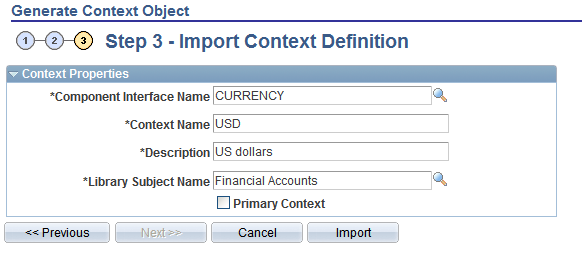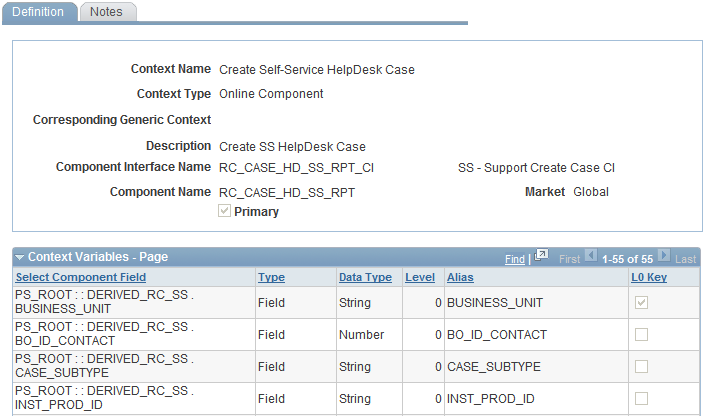Configuring Contexts
This section discusses how to generate and manage context objects.
|
Page Name |
Definition Name |
Usage |
|---|---|---|
|
EOCF_CTX_IMPORT |
Generate context objects. |
|
|
EOCF_CONTEXT_DEFN |
Manage context objects. |
|
|
Manage Context Object - Notes Page |
EOCF_CTXDEFN_NOTES |
Enter text descriptions for context objects. |
Use the Generate Context Object page (EOCF_CTX_IMPORT) to generate context objects.
Navigation:
This example illustrates the fields and controls on the Generate Context Object page (1 of 4). You can find definitions for the fields and controls later on this page.

Field or Control |
Description |
|---|---|
Component Interface Name |
Used to extract the contents of a PeopleSoft component for use in generating the context. A component interface is required to create an online context. |
Context Name |
The required, unique, and descriptive name of a context. |
Description |
The required, appropriate description of the intent of this context. |
Library Subject Name |
The default subject area for terms created by this process. The prompt for this field shows the subject area selection list. |
Primary Context |
Select to denote the context to be generated as the primary context for this online transaction. |
This example illustrates the fields and controls on the Generate Context Object page (2 of 4). You can find definitions for the fields and controls later on this page.

Review and configure the context variables and terms that were automatically generated based on the component interface that you selected. Select the Log check box to denote that the field should be logged when a context is persisted at runtime (this is a key to the transaction, and the process automatically sets this field).
Select the Term Options tab to create a new term for each context variable that is created. Also, you can add a contextual implementation to an existing term for this context variable.
Select the Subject Area tab if you want to override the default subject area chosen on the first page.
This example illustrates the fields and controls on the Generate Context Object page (3 of 4). You can find definitions for the fields and controls later on this page.

Select Import to create the context and terms. The Generate Context Object page displays the import details.
This example illustrates the fields and controls on the Generate Context Object page (4 of 4). You can find definitions for the fields and controls later on this page.

Use the Manage Context Object - Definition page (EOCF_CONTEXT_DEFN) to manage context objects.
Navigation:
This example illustrates the fields and controls on the Manage Context Object - Definition page (1 of 2). You can find definitions for the fields and controls later on this page.

This example illustrates the fields and controls on the Manage Context Object - Definition page (2 of 2). You can find definitions for the fields and controls later on this page.

You can, if applicable, enter descriptive information in the text box on Manage Context Object - Notes page.
Field or Control |
Description |
|---|---|
Corresponding Generic Context |
This field is used to programmatically create a standalone context from its corresponding online context. Applications directly embedding data library terms need this information to supply context information to the data library runtime engine. |
Context Variables - Page |
This section is used to define the page context variables.
|
Context Variables - Term |
This section defines the context variables of the type term.
|
Context Variables - Constant Value |
This section defines the context variables of the type constant.
Note: A constant value specified for a context variable cannot be overridden at runtime. |
Operator Set |
Optionally, specify an operator set to be used for this context. This operator set is used to present the list of valid operators for selected terms in policy conditions. A default operator set is automatically entered. |